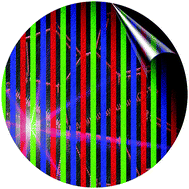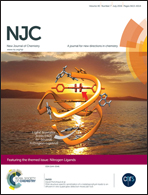Photoluminescent polymer composites with R, G, B emission and their potential applications in LCD displays
Abstract
In this work, red, green and blue emitting composites with remarkable photoluminescence properties were obtained through embedding Eu3+, Tb3+ and Y3+ complexes with 2-(1H-1,2,4-triazol-3-yl)pyridine in poly(vinyl alcohol) and poly(n-vinyl pyrrolidone) matrices which were processed in thin or thick films. Interestingly, through embedding in the polymer matrices, their luminescence properties are markedly enhanced compared to the free complexes. PLQY values were enhanced from an average 25–30% to 52–69%, while the emission purity, especially in the case of Eu3+ containing composites, was greatly improved. The prepared composites were investigated through FT-IR analysis while the emphasis on fluorescence spectroscopy provided important details regarding the impact of embedding the complexes in the polymer matrices; luminescence lifetime, absolute PLQY and chromaticity parameters were investigated in detail. The morphology of the composite films was investigated through AFM and SEM. Based on their remarkable photoluminescence properties we are suggesting their implementation in AMLCD displays in a new approach which could replace the RGB colour filters, thus bringing several potential advantages over the current approach. The facile preparation and emission characteristics should be important arguments for their implementation as photonic conversion media in various optoelectronic devices. Other applications like full colour watermarks in special purpose papers could easily take advantage of the prepared composites.


 Please wait while we load your content...
Please wait while we load your content...